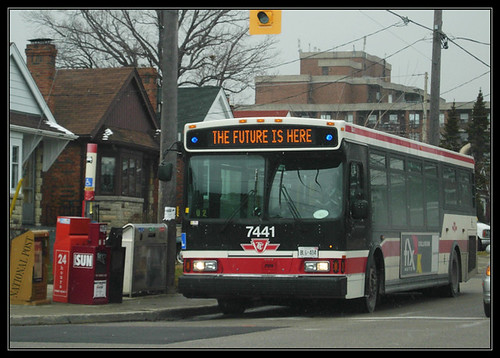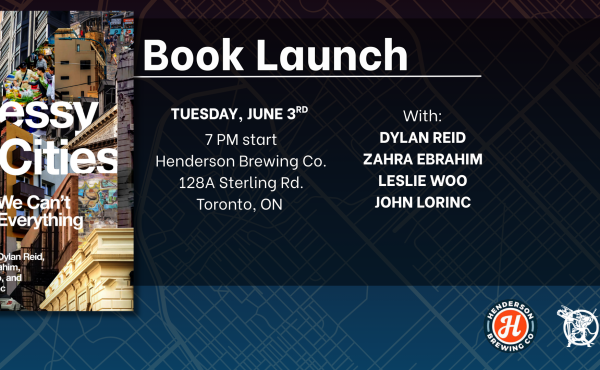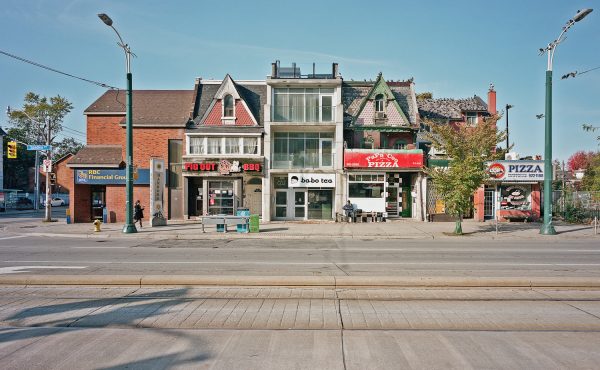UPDATE: The TTC has just issued a press release heralding the surface route service improvements coming this Sunday. The TTC website now has the details here. The press release also says that the TTC has also just hit a new record for ridership from mid-November 2007 through mid-November 2008, of 465 million rides. This breaks the 1988 record of 463.5 million, yet we are not yet at the same service levels on many routes (particularly the streetcar network) that we had 20 years ago.
Previously posted October 26:
The oft-delayed TTC Ridership Growth Strategy reaches a milestone on November 23, when all routes currently operating are subject to a new maximum headway (the time between scheduled buses on a route) of every 30 minutes. Effectively, this guarantees nearly every city resident bus service until after 1AM, 7 days a week, even on the least-patronized routes, like the 120 Calvington, where buses only run hourly during peak periods. In addition, there are some other minor service improvements to some of the busiest routes intended to help with overcrowding. Finally,the new Mount Dennis garage will open to handle the increased number of buses. Both these service improvements and the garage opening come a year late due to David Miller’s controversal mandated TTC funding cutbacks.
The last major service improvement, in February 2008, was kept from the public until two days before the scheduled implementation, going so far as to embargo the service summary that is normally posted on the website a week or two before the changes. However, Steve Munro obtained details on the service improvements early, and can be found as a link on his blog.
Previously, the planned service improvements were going to guarantee a bus every 20, not 30 minutes. We may not see the 20-minute standard take place for at least another year, partly due to delayed funding. As well, hiring enough new drivers, and the failures of the hybrid buses are also complications. Munro also notes that even with massive ridership growth over the past few years (rivalling, or even surpassing the 1988 ridership record of 463.5 million), the total amount of service hours are still slightly below that of 1990. As anyone who has been stuck on a crushloaded streetcar or bus can attest, there is still much work to be done.
Photo by eskimo_jo





18 comments
Great to see this kind of coverage on Spacing. Like it or not, the TTC is mainly a bus service in that buses are what most people use at some point in their transit journey. Streetcars are cute icons but were never really implemented beyond the old city. The subway is great, but it is 2.5 lines in a city of millions. I wish it were not so, but Toronto depends on buses to get people where they are going – so good to follow bus news closely.
I love how the TTC considers getting buses to a stop every half hour an achievement.
The STM in Montreal has been doing it for years, and they don’t have the bad jokes like multiple buses following each other, or short stops either.
What they do have are scheduled points of departure at each of the routes.
What they do have are buses leaving every 5-10 minutes from key arterial points, such as major metro stations that allow people to get out of the downtown core to the suburbs quickly.
On non major routes during rush hours, the buses run every 15 minutes, almost without fail.
I just don’t get Toronto.
The TTC considers this a good thing. Something to crow about. I look it as still pathetic service, not worthy of even commenting on.
Christopher, the problem lies with TTC and their outdated, militaristic approach to everything service oriented excepting of course the employees productivity.
It’s then galvanized by a union focused mayor and ditto for the TTC Chair.
Want significant changes… they start at the top.
The STM should not be the standard the TTC should follow for bus services. The STM might have a 30 minute service standard (though many routes still have only hourly service, like the 29 Rachel), but it sticks to this standard when there should be more buses. Route 24 Sherbrooke is comically underserved, and don’t get me started on the 55 St-Laurent.
The TTC’s bus services on the major routes can be bad for overcrowding, thanks partly due to poor line management and backlogs of unimplemented service improvements, but it’s a great network for the most part, at least most of the time.
A few additions to our subway is a given, and I’m not even convinced most of the Transit City lines will help (but that’s for another day).
Maybe Quebec actually gives their municipal transit systems the funding they need, instead of downloading costs. Almost every weakness in the TTC can ultimately be linked to the lack of provincial and federal investment in the system.
“Streetcars are cute icons but were never really implemented beyond the old city.”
Actually, they were, since they connected the “streetcar suburbs” with the old city. The streetcar network was extensive. But the routes were replaced with buses and tracks were ripped out or (more likely) paved over, cobblestones and all.
Is this the best way to use additional buses? What is better, to increase the frequency on bus routes with low ridership, or to add buses to routes that have overcrowding problems but already have frequent service?
It seems like the 30-minute target aims to achieve a balance. Going with a 20-minute standard could mean that there aren’t enough resources left to battle overcrowding.
I am very happy to see the sheer number of improvements being made, and my only hope is that the TTC can find a way to maximise the benefits from making these improvements. Obviously there is a major cost associated with increasing service by so much, but I assume that the vast majority of this will be consumed by expanding service on routes that presently have low ridership (like 120 Calvington). So if the TTC can put real effort into attracting a new ridership base to these costly, underused routes (which may be underused simply because they’re underserved) then they will go a long way towards actually recovering the costs of the increased service.
Jeff, many of the improvements to infrequent routes are at off-peak times, and make use of buses that would otherwise only be used during rush hour.
It looks as though most of the peak period increases are on already busy routes (Eglinton, Sheppard, Finch, etc.) in an attempt to reduce crowding.
Core streetcar service may be impaired with the new and larger streetcars. How? The logic is that since they will be larger/longer, the capacity will be increased and that means fewer streetcars can provide the same “capacity” with fewer drivers and yes, less frequency. May I suggest this is a major problem, and we should also rename the transit expansion plan Transit Suburbs as there’s really no improvement in old core service, which is usually where the TTC makes money, and the lower density old suburban service where costs rise.
Hamish, do you think that the city was some great, dense, metropolis when the original streetcars were built?
I agree with Hamish that larger and longer capacity streetcars have the effect of replacing smaller more frequent streetcars, to the large decrease of ridership on such lines.
Look at 501 Queen and 511 Bathurst (on SteveMunro.ca), which are mainly articulated streetcar served in the last 20 years, and their ridership’s considerably less than 20 years ago. All the other streetcar lines have seen increases in ridership over the same period.
Despite what the TTC claims is changing demographics along Queen and Bathurst, this doesn’t hold water given the increase in ridership on parallel streetcar routes 504 King and 510 Spadina.
AR – you misunderstood me. What I meant was that the streetcar network does not extend much beyond the old City of Toronto. Yes, there are a couple lines like the old Mt Pleasant that are now gone along with some interurbans to more distant places, but even if those were still around the streetcar would still not be a way to get from Guildwood to Agincourt. The TTC is a bus network feeding a subway backbone.
Overcrowding on Eastbound Eglinton buses could be greatly relieved by a 45 minute Eglinton subway-to-Mt. Pleasant shuttle, from 8:30 to 9:15. At least three quarters of the riders getting on buses at Eglinton station get off at Mt. Pleasant, most of them students from the area high schools. Riders going beyond that point fail to get a spot on the packed buses which spill out most of their passengers just a few short blocks away.
might i suggest that the ttc is a bus AND streetcar network feeding a subway backbone? i don’t really see the point in oversimplifying something that is pretty simple in the first place…
Thanks for NOTHING on the College line.
Saturday morning? How about that delay between 5 and oh, 5:45 on every weekday evening. And no, that’s not cars bunching up, that’s a delay I have seen for the past four years. That’s poor planning. Beyond poor. Argh.
There isn’t enough streetcars available to improve service on all routes.
And to uSkyscraper: The streetcars also feed the subway network, and they work the busiest routes in the city. “Cute icon” Hardly. The streetcars are just as important as the buses, and transit city will be a vast improvement on certain routes. The Finch West bus is a perfect example. I am not deying that we need subway extensions to certain areas, but streetcars as just as important. The increasing number of proposals in the US is proof of this.
Let’s not turn this into a bus vs. streetcar debate. We should be lucky that we have a diverse system in place.
Hamish raise a great point about reducing service due to longer streetcars. The TTC seems to be following that logic, and I believe that many advocates have made the TTC aware of it’s mistake.
The 501 needs more streetcars, plain and simple. Why they use the ALRV’s on that route is beyond me.
Just checking — has anyone heard if any routes actually increased headways to 30 minutes? I.e. were there any routes with 22 or 24 minute (off-peak) service that “harmonized” with the 30 minute promise?
Whether or not that is the case, this service boost allows many occasional transit riders to consider taking TTC for optional trips, or staying out later.
Of course, some off-peak newbies may eventually be turned off by other aspects of the journey — such as the level of TTC customer service or actual on-time performance of these additional buses.
The test will be how ridership fares over the next while, especially considering the economic situation.